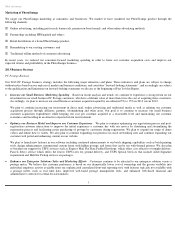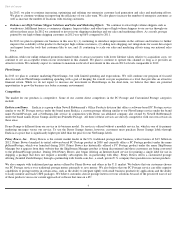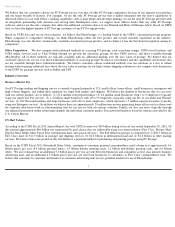Stamps.com 2012 Annual Report Download - page 19
Download and view the complete annual report
Please find page 19 of the 2012 Stamps.com annual report below. You can navigate through the pages in the report by either clicking on the pages listed below, or by using the keyword search tool below to find specific information within the annual report.
If we are unable to compete successfully, particularly against large, traditional providers of postage products, such as Pitney Bowes, our
revenues and operating results will suffer.
The PC Postage segment of the market for postage is relatively new and is competitive. At present, Pitney Bowes and Endicia.com (a wholly
owned subsidiary of Newell Rubbermaid) are authorized PC Postage providers with commercially available software. If any more providers
become authorized, or if Pitney Bowes or Endicia.com provide enhanced offerings, our operations could be adversely impacted. We also
compete with other forms of postage, including traditional postage meters provided by companies such as Pitney Bowes, postage stamps and
permit mail.
We may not be able to establish or maintain a competitive position against current or future competitors as they enter the market. Many of our
competitors have longer operating histories, larger customer bases, greater brand recognition, greater financial, marketing, service, support,
technical, intellectual property and other resources than us. As a result, our competitors may be able to devote greater resources to marketing and
promotional campaigns, adopt more aggressive pricing policies and devote substantially more resources to web site and systems development.
This increased competition may result in reduced operating margins, loss of market share and a diminished brand. We may from time to time
make pricing, service or marketing decisions or acquisitions as a strategic response to changes in the competitive environment. These actions
could result in reduced margins and seriously harm our business.
We could face competitive pressures from new technologies or the expansion of existing technologies approved for use by the USPS. We may
also face competition from a number of indirect competitors that specialize in electronic commerce and other companies with substantial
customer bases in the computer and other technical fields. Additionally, companies that control access to transactions through a network or Web
browsers could also promote our competitors or charge us a substantial fee for inclusion. In addition, changes in postal regulations could
adversely affect our service and significantly impact our competitive position. We may be unable to compete successfully against current and
future competitors, and the competitive pressures we face could seriously harm our business.
If we do not respond effectively to technological change, our services and products could become obsolete and our business will suffer.
The development of our services, products and other technology entails significant technical and business risks. To remain competitive, we must
continue to enhance and improve the responsiveness, functionality and features of our online operations. The Internet and the electronic
commerce industry are characterized by rapid technological change, changes in user and customer requirements and preferences, frequent new
product and service introductions embodying new technologies, and the emergence of new industry standards and practices.
The evolving nature of the Internet or the postage markets could render our existing technology and systems obsolete. Our success will depend,
in part, on our ability to (i) license or acquire leading technologies useful in our business, (ii) enhance our existing services, (iii) develop new
services or features and technology that address the increasingly sophisticated and varied needs of our current and prospective users, and (iv)
respond to technological advances and emerging industry and regulatory standards and practices in a cost-effective and timely manner.
Future advances in technology may not be beneficial to, or compatible with, our business. Furthermore, we may not be successful in using new
technologies effectively or adapting our technology and systems to user requirements or emerging industry standards on a timely basis. Our
ability to remain technologically competitive may require substantial expenditures and lead time. If we are unable to adapt in a timely manner to
changing market conditions or user requirements, our business, financial condition and results of operations could be seriously harmed.
Our operating results could be impaired if we or the Internet become subject to additional government regulation.
Changes in the laws and regulations applicable to the Internet or us, including those relating to user privacy, pricing, content, copyrights,
distribution, characteristics and quality of products and services, and export controls, could seriously harm our business, financial condition and
results of operations. Moreover, the applicability of existing laws to the Internet is uncertain with regard to many issues, including property
ownership, export of specialized technology, sales tax, state income taxes, libel and personal privacy, and changes in their interpretation could
similarly harm us. The application of laws and regulations from jurisdictions whose laws do not currently apply to our business, or the
application of existing laws and regulations to the Internet and other online services could also harm our business.
Table of Contents
15
























